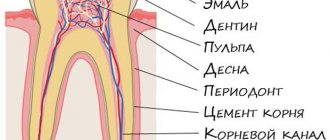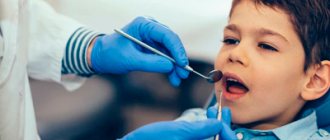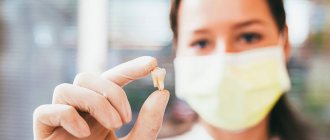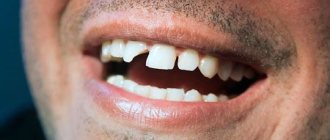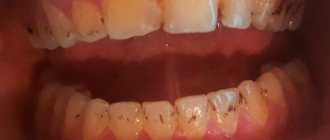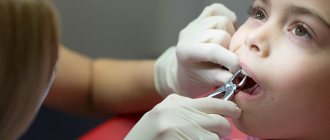04.08.2016
baby shower
Summer holidays are a joy for children and a hassle for parents. Kids spend a lot of time outside, frolicking in the yard, and sometimes games can lead to injuries. One of the common reasons for visiting a pediatric dentist is dental injuries.
But we hasten to reassure you, there is no need to panic - the tooth can be saved. The main thing is to take the right measures in the first half hour and immediately consult a doctor.
Baby tooth injury
If a child knocks out a baby tooth, don’t worry: a new one will grow in its place. Let your mouth rinse with a disinfectant. But it won’t be superfluous to show your baby to the doctor, don’t hesitate.
If you are interested in the question: “Is it possible to put a knocked-out tooth back?”, then we answered this question in more detail below.
We divide all dental injuries of children
- Bruise - characterized by only minor damage, a crack in the enamel, hemorrhages in the pulp chamber, swelling, or bruising on the gums may be observed.
- Subluxation - a damaged tooth is displaced, its ligamentous apparatus and neurovascular bundle are partially damaged, and tooth mobility is noted.
- Luxation - incomplete and complete - the tooth protrudes significantly from the dentition, barely maintaining connection with the socket, or even falls out of it. The integrity of the neurovascular bundle and ligamentous apparatus of the tooth is compromised.
- Fracture of the crown of the tooth.
- Tooth root fracture
Further in the article we will tell you how acute injury to baby teeth in children is characterized by an impact, how to recognize an injury to the front teeth, and how to treat any tooth injury in a child.
What to do if a child knocks out a tooth?
Sports and outdoor games are good for children's health, but sometimes troubles happen, such as a knocked out tooth. In such a situation, parents can help if they know what to do. Although losing a baby tooth doesn't seem like a very serious problem, you should still visit your dentist. As for permanent teeth, sometimes it is possible to re-attach them. Otherwise, the dentist will find an aesthetic solution and restore a beautiful smile.
The child knocked out a tooth
To stop bleeding, place a sterile bandage on the socket. Have your child bite down on the tampon to keep it in place. Comfort your child and try to find the missing tooth. You should only pick up the tooth by the crown; do not touch the root of the tooth. It is advisable to rinse the tooth with milk, but first cover the hole in the sink to prevent the tooth from being washed down the drain. Do not rub the tooth or remove pieces of dental tissue. Gently insert the tooth into the socket, or if this is not possible, place it in a clean container with milk, salted water or saliva. Do not wrap the tooth in a napkin; you must not allow it to dry out; this reduces the likelihood of reimplantation. Take your child to the dentist as soon as possible and bring the tooth with you. If you can't find the tooth, check to see if it is stuck in your child's mouth. The dentist will take an x-ray to locate the tooth and identify other injuries.
What can happen
Losing baby teeth is a natural process, but premature tooth loss due to an accident or injury can have complications. When baby teeth are pressed into the gums, they prevent the permanent teeth underneath from growing. The remaining teeth may shift into the place of the knocked-out tooth, and there will not be enough space for the permanent tooth to grow. Curvature of teeth and difficulty chewing may occur. The dentist will prevent complications by placing a retainer in the child's mouth until the permanent tooth emerges. A space maintainer is an orthodontic appliance that is placed in place of a lost tooth to maintain space between teeth until the permanent tooth emerges.
Sometimes knocked out permanent teeth can be reimplanted and held in place for several weeks. The dentist will attach the knocked-out tooth to adjacent teeth using thin orthodontic wire. Gradually, the ligaments connecting the tooth to the bone will recover. At the next appointment, the dentist will check whether the tooth has healed successfully and whether the splint can be removed.
Replacing missing tooth
If it was not possible to implant a permanent tooth, then you can restore a beautiful smile with the help of a dental implant or bridge. An implant is a titanium post that is inserted into the jaw. It grows into bone within about three months. When the implant is firmly fixed in the jaw, the orthopedist will install a support for the crown on its protruding part, and then put on the crown itself. A dental bridge is one or more artificial teeth that are attached to the patient's own teeth on both sides. Installation of an implant or bridge usually requires several visits to the doctor. Caring for an implant or bridge should be as careful as caring for your teeth: you need regular dental checkups, brushing with dental floss and toothpaste.
It is difficult to remain calm after seeing a child knock out a tooth. But first aid measures and an immediate visit to the dentist will save the tooth and avoid complications. Even if it is not possible to save the tooth, the dentist will offer you an alternative. Parents who know what to do are able to cope with this situation.
Trauma to the front teeth in a child
The front teeth in children are most often injured. And while injury to other teeth may go unnoticed, injury to a child’s front teeth quickly attracts the attention of parents. An ordinary bruise, in which only a barely noticeable crack in the enamel can be visually seen, may not bother the child in any way. In some cases, there may be discomfort or pain during chewing, or mechanical stress, and slight swelling of the soft tissues.
It’s another matter if, as a result of an injury, a subluxation, dislocation, or even fracture of a tooth occurs. Then the injury to the child’s front teeth is primarily visually noticeable. In the case of subluxation or dislocation, parents may notice an atypical position of the tooth, its slight displacement relative to other teeth. In addition, with this type of injury to the front teeth, bleeding, swelling of the soft tissues, inflammation, severe pain, and mobility of the injured tooth will be noted.
Children often experience fractures of their front teeth. It will be characterized by a violation of the integrity of hard tissues, chipping of a part of the tooth, pain, bleeding, swelling of soft tissues, and hemorrhages in them.
What consequences may there be
A piece of teeth knocked out in childhood can lead to the following complications:
- malocclusion: neighboring teeth will shift, preventing the formation of permanent teeth,
- speech defects: their risk especially increases with the loss of incisors, which take an active part in articulation,
- diseases of the digestive tract: the inability to thoroughly chew food leads to its insufficient processing by oral enzymes, swallowing in pieces, which over time provokes gastrointestinal diseases.
Also among the negative consequences can be noted: violation of the aesthetics of the dentition, the appearance of problems in communicating with peers, an increased risk of pathologies in neighboring units, frequent inflammation even after successful treatment.
Acute dental trauma in children due to impact
Acute tooth trauma in a child upon impact is characterized primarily by damage to the periodontium - parts of its fibers are torn, small blood vessels and nerves are damaged. The degree of damage directly depends on the strength of the mechanical damage and on what kind of tooth injury occurred in the child during the impact - bruise, dislocation, or fracture.
Almost any acute dental injury in children resulting from a blow is accompanied by severe pain, swelling of soft tissues and hemorrhages in them. Bleeding is also very common. The pain intensifies during mechanical stress and chewing. Often acute dental trauma in children resolves with the impact of the tooth root into the jaw. Then, in addition to the symptoms described above, a visual shortening of the injured tooth will be observed.
In what cases should you consult a doctor?
Unfortunately, when a tooth is knocked out, especially in the absence of bleeding, people rarely go to the dentist. However, parents need to be vigilant and pay attention not only to the absence of a unit in the dentition, but also to other symptoms that indicate infection has penetrated into the wound and the development of complications. These signs include the following:
- increasing pain at the site of the defect,
- redness and swelling of the gums around the wound,
- purulent discharge from the damaged area,
- temperature increase: even slight,
- the tooth is intact, but is loose or spinning in the socket,
- if the unit is intact, visually it looks pressed into the hole.
“As a rule, if a baby tooth is knocked out, it is lost completely, from the root. Temporary units are not so firmly fixed in the holes, and a slight blow is enough to lose them. In the case of permanent ones, a fracture occurs more often - their roots are stronger and go deeper into the bone, so it is more difficult to knock them out,” says expert, dental therapist Oksana Vladimirovna Titova.
How to treat a baby tooth injury
Injury to a baby tooth in children is most often represented by a bruise or dislocation. Treatment in this case involves, first of all, resting the tooth for about 3-4 weeks (excluding solid food from the diet, grinding off the cutting edge of the crown of the antagonist tooth). If the pulp is damaged and irreversible changes have developed in it, it is removed and the canal is sealed.
If an injury to a baby tooth occurs, such as a dislocation, treatment will also depend on the viability of the injured tooth. If the bone tissue is preserved for at least half the length of the tooth, it is preserved. The baby tooth is placed in its original position and its mobility is limited by splinting. Next, the question of the advisability of preserving the pulp is decided.
If complete dislocation occurs, the tooth can also be replanted, but only if no more than 2 hours have passed since the injury.
In case of fractures, the lost parts of the tooth are restored using composite filling materials.
You can get a full range of treatment recommendations from dentist Olga Olegovna Moiseenko
Fracture of the upper part of the tooth (crown)
Another common case in practice is crown fracture. In such a circumstance you need:
- Treat the mucous membrane at the fracture site with an oral disinfectant solution.
- To avoid swelling, apply a cold compress to the injury site.
- If a sharp edge forms, cover it (put some cotton wool) so as not to damage the lip and tongue.
- Seek medical help.
These simple steps must be performed quickly. See a doctor urgently!
Symptoms of a tooth bruise
Depending on how long and intensely the tooth hurts after a bruise, one can draw conclusions about the severity of the injury.
Often, immediately after the blow, it seems that the pain gradually subsides and will soon go away completely. However, over time, the discomfort only intensifies, and when pressure is applied to the tooth itself or the gum next to it, the pain can become unbearably strong. In addition to pain, the following symptoms may be observed:
- the gums in the area of the bruised tooth swell, a hematoma or edema appears;
- the tooth may acquire a reddish tint due to blood released into the pulp from ruptured vessels;
- bruising of the front teeth can lead to noticeable loosening of individual incisors (it seems to the person that the tooth does not hold well and may fall out);
- Over time, the crown may noticeably darken due to disruption of the nutrition of dental tissues and the penetration of pollutants into enamel cracks.
Any of the listed symptoms is a serious enough reason to contact a dental clinic as soon as possible. Painful sensations always indicate the presence of damage, which can eventually lead to the loss of a healthy-looking tooth.
Causes
The reasons why a child breaks a permanent tooth are most often blows to the face or falls. An accident can occur during sports, outdoor games, or simply due to the carelessness of the child himself.
Much less often, such injuries occur due to biting or chewing hard foods. But it should be borne in mind that children with nutritional deficiencies, who suffered from rickets in childhood, and those suffering from enamel hypoplasia and malocclusion are more prone to this type of dental damage.
Deep caries also greatly increases the likelihood of tooth fracture: the cavity created by this disease makes the tooth more vulnerable to fracture.
Tooth bruise - what to do?
Please note that it is impossible to determine the severity of the injuries yourself. A complete diagnosis must include an x-ray and a professional examination in a dental office. At home, an experienced dentist can examine the damage and make certain assumptions, but even without the necessary tools, he will not be able to make an accurate diagnosis.
If it is obvious that the tooth bruise is quite serious, self-treatment is unacceptable. To ease the pain, you can apply ice or just a cold object and go to the dentist as quickly as possible. If it looks like the jaw is damaged, it is advisable to fix it with a bandage. It is advisable that someone accompany the victim, since he may lose consciousness on the road.
Do I need to insert a tooth myself?
In case of incomplete dislocation, the crown that protrudes strongly from the gums at the scene of the incident can be carefully inserted into place without applying significant effort. This will prevent complete tooth loss, the likelihood of which is quite high. But you shouldn’t touch a knocked-out baby tooth; it’s better to quickly go to the dentist to identify possible damage to soft tissue and bone.
If a piece of a tooth breaks off, you should rinse your mouth with clean water, try to find the fragment and rush to see a qualified doctor.
Prevention
It is impossible to insure against a fall or other accident. But you can teach your child the basic principles of general safety and rules for maintaining dental health. Explain to your child the dangers of biting candy, nuts, or opening any packages with your teeth.
In addition, take care to eliminate provoking factors. Contact a pediatric orthodontist if your child has malocclusions, crowded teeth, or other signs of malformation of the dental system.
Regularly undergo a course of remineralization therapy for hypoplasia or aplasia (deficiency of tooth enamel or its complete absence).
Do not delay treatment of caries - if at an early stage this disease does not require significant medical intervention, then as it develops it will not only cause pain to the child, but will also become a circumstance that greatly increases the likelihood of a fracture.
Complications
The danger of losing permanent teeth is obvious: these teeth must perform their functions throughout a person’s life, and naturally, the loss of even one tooth is extremely undesirable.
But a tooth fracture can cause “current” complications - those that you don’t have to wait for your whole life:
- Injury to the soft tissues of the oral cavity by a fragment of a tooth or its sharp part.
- Infection of deep periodontal tissues through a crack in the tooth.
- Violation of the growth of other teeth and the formation of an incorrect bite.
- Diseases of the gastrointestinal tract due to poor chewing of food.
This is not a complete, but quite convincing list of possible complications. Therefore, it is important to consult a doctor at the first signs of injury - this will allow you to “save” the tooth, if possible, and prevent the development of negative consequences.
How to restore a knocked out tooth
When contacting a dentist, first of all, he will perform an antiseptic treatment of the wound and prescribe an x-ray. Subsequent actions will depend on the nature of the damage.
So, if a tooth is completely knocked out, the doctor can insert it (provided it is intact) in the near future into the hole, ensuring fixation with a splint; if necessary, stitches are placed on the wound. On average, engraftment lasts about two months, during which you will need to regularly visit a specialist. In the future, observation by an orthodontist will be required.
If the tooth “hangs” on the gum, after anesthesia, the doctor carries out appropriate treatment. This could be: suturing a wound, filling canals, fixing a broken part of a crown, and so on depending on the situation. All actions are carried out on the basis of radiographic data.
“When my son broke his upper incisor, the dentist re-seated part of the crown with some kind of compound. For two years we protected this incisor, followed a soft diet and so on. Now it has fallen out safely, and the new one is growing without problems...”
Elizaveta O. (from a message on the woman.ru forum)

